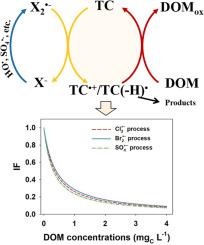当前位置:
X-MOL 学术
›
Water Res.
›
论文详情
Our official English website, www.x-mol.net, welcomes your
feedback! (Note: you will need to create a separate account there.)
The reverse-reduction effect of dissolved organic matter on the degradation of micropollutants induced by halogen radicals (Cl2•- and Br2•-)
Water Research ( IF 11.4 ) Pub Date : 2024-10-30 , DOI: 10.1016/j.watres.2024.122720 Shuangshuang Cheng, Rui Cui, Yangjian Zhou, Yu Lei, Ni Wang, Yanheng Pan, Xin Yang
Water Research ( IF 11.4 ) Pub Date : 2024-10-30 , DOI: 10.1016/j.watres.2024.122720 Shuangshuang Cheng, Rui Cui, Yangjian Zhou, Yu Lei, Ni Wang, Yanheng Pan, Xin Yang

|
Reactive halogen radicals (e.g., Cl2•- and Br2•-) greatly impact the degradation of micropollutants in natural waters and engineered water treatment systems. The ubiquitous dissolved organic matter (DOM) in real waters is known to greatly inhibit the degradation of micropollutants by reducing micropollutant's intermediate (i.e., TC•+/TC(-H)•), however, such DOM's effects on the halogen-radical-induced system have not been understood yet. The present study focuses on investigating and quantifying such inhibitory effects of DOM during Cl2•-- and Br2•--mediated process. Guanosine (Gs) was selected as a model compound. The transient spectra show that Cl2•- and Br2•- react with Gs generating intermediates (i.e., Gs•+/Gs(-H)•) via single-electron transfer. In the presence of 1.0 mgC L-1 DOM, over 70% of this oxidized Gs was reduced back to Gs. Comparing the extent of reverse-reduction inhibitory among different reaction systems, this inhibitory in Br2•- system was slightly lower than that in Cl2•- and SO4•- system, corresponding the slightly difference of inhibition factor (IF) values as SO4•- < Cl2•- < Br2•-. The reverse-reduction effect of DOM was further quantified for 19 common micropollutants. It varied significantly with IF values of 0.21–1.26 and 0.28–1.40 in Cl2•-- and Br2•--mediated process, respectively. Purines and amines generally exhibited more pronounced inhibition than phenols in both systems. A good correlation of IF values with micropollutant's reduction potential was observed, which can be applied to predict the degradation of more unstudied micropollutants. This study highlights the important role of the reverse-reduction effect of DOM on micropollutant degradation. It can significantly improve the accuracy in predicting degradation rate in advanced oxidation processes for treating water containing halides.
中文翻译:

溶解有机物对卤素自由基 (Cl2•- 和 Br2•-) 诱导的微污染物降解的逆还原作用
活性卤素自由基(例如 Cl2•- 和 Br2•-)对天然水和工程水处理系统中微污染物的降解有很大影响。众所周知,实际水中无处不在的可溶性有机物 (DOM) 通过减少微污染物的中间体(即 TC•+/TC(-H)•))来极大地抑制微污染物的降解,然而,这种 DOM 对卤素自由基诱导系统的影响尚不清楚。本研究的重点是研究和量化 DOM 在 Cl2•--和 Br2•--介导过程中的这种抑制作用。鸟苷 (Gs) 被选为模型化合物。瞬态光谱显示,Cl2•- 和 Br2•- 与 Gs 反应,通过单电子转移生成中间体(即 Gs•+/Gs(-H)•)。在 1.0 mgC L-1 DOM 存在下,超过 70% 的氧化 Gs 被还原回 Gs。比较不同反应体系之间的反向还原抑制程度,Br2•- 体系中的抑制作用略低于 Cl2•- 和 SO4•- 体系,对应于抑制因子 (IF) 值的略微差异,为 SO4•- < Cl2•- < Br2•-.进一步量化了 19 种常见微污染物的 DOM 反向还原效应。在 Cl2•-- 和 Br2•-介导的过程中,它分别以 0.21-1.26 和 0.28-1.40 的 IF 值显著变化。 在这两个系统中,嘌呤和胺通常比酚类表现出更明显的抑制作用。观察到 IF 值与微污染物的还原电位具有良好的相关性,这可用于预测更多未研究的微污染物的降解。本研究强调了 DOM 的逆还原效应对微污染物降解的重要作用。它可以显著提高在处理含卤化物水的高级氧化过程中预测降解速率的准确性。
更新日期:2024-10-30
中文翻译:

溶解有机物对卤素自由基 (Cl2•- 和 Br2•-) 诱导的微污染物降解的逆还原作用
活性卤素自由基(例如 Cl2•- 和 Br2•-)对天然水和工程水处理系统中微污染物的降解有很大影响。众所周知,实际水中无处不在的可溶性有机物 (DOM) 通过减少微污染物的中间体(即 TC•+/TC(-H)•))来极大地抑制微污染物的降解,然而,这种 DOM 对卤素自由基诱导系统的影响尚不清楚。本研究的重点是研究和量化 DOM 在 Cl2•--和 Br2•--介导过程中的这种抑制作用。鸟苷 (Gs) 被选为模型化合物。瞬态光谱显示,Cl2•- 和 Br2•- 与 Gs 反应,通过单电子转移生成中间体(即 Gs•+/Gs(-H)•)。在 1.0 mgC L-1 DOM 存在下,超过 70% 的氧化 Gs 被还原回 Gs。比较不同反应体系之间的反向还原抑制程度,Br2•- 体系中的抑制作用略低于 Cl2•- 和 SO4•- 体系,对应于抑制因子 (IF) 值的略微差异,为 SO4•- < Cl2•- < Br2•-.进一步量化了 19 种常见微污染物的 DOM 反向还原效应。在 Cl2•-- 和 Br2•-介导的过程中,它分别以 0.21-1.26 和 0.28-1.40 的 IF 值显著变化。 在这两个系统中,嘌呤和胺通常比酚类表现出更明显的抑制作用。观察到 IF 值与微污染物的还原电位具有良好的相关性,这可用于预测更多未研究的微污染物的降解。本研究强调了 DOM 的逆还原效应对微污染物降解的重要作用。它可以显著提高在处理含卤化物水的高级氧化过程中预测降解速率的准确性。


















































 京公网安备 11010802027423号
京公网安备 11010802027423号